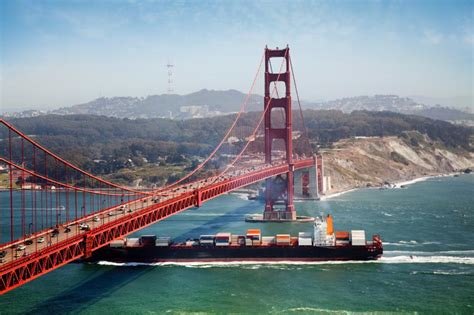San Francisco’s Golden Gate Bridge is one of the most recognizable symbols of the city, and it has been a part of the landscape since 1937. But why is it so aptly named?
The first written reference to the strait as the Golden Gate dates to the 1850s, when gold was discovered in the area. During the California Gold Rush, thousands of people traveled to the area hoping to strike it rich. The strait was the only way to get to the gold fields, so it became known as the Golden Gate.
The name Golden Gate was also used in the 19th century to refer to the entrance of the San Francisco Bay, but it wasn’t until the early 20th century that the name was applied to the bridge. It was originally planned to be called the Bridgeway, but a local newspaper editor is credited with suggesting the name Golden Gate Bridge in a bridge competition.
The name was a tribute to the area’s rich history and the passage that has served as an important port for centuries. It was a fitting name for a bridge that is now recognized around the world as a symbol of San Francisco and the Bay Area.
Today, the Golden Gate Bridge stands as a testament to the area’s colorful past and its place in the history of California. It is an iconic landmark that will always be linked to the city and its inhabitants.
Exploring The Name Origins Of San Francisco’s Iconic Golden Gate Bridge
The San Francisco Bay is crowned with one of the world’s most iconic bridges and the gateway to the city is the Golden Gate Bridge. Spanning the strait between San Francisco Bay and the Pacific Ocean, it is one of the most recognizable symbols of the city. But why is it called the Golden Gate Bridge?
The Golden Gate Bridge was originally named by engineer Joseph Strauss in his original design proposal for the bridge. He called the bridge “the Golden Gate Bridge” after the strait it spans, the Golden Gate Strait, which itself was named by John C. Fremont. Fremont named the strait after the golden-hued sunsets that are so prevalent in the area. It was his way of referring to the narrow entrance to the San Francisco Bay.
The Golden Gate Bridge project was approved in 1928 and took four years to complete. The bridge was officially opened to the public on May 27, 1937, and was declared a National Historic Landmark in 1987. Today, it is a much-visited tourist attraction, with more than 10 million visitors each year.
The bridge is made of steel and is painted an orange-vermilion color that can be seen from miles away. It weighs more than 800,000 tons and is held together by 1.2 million rivets. The bridge is suspended from two towers that are 746 feet high, making it one of the tallest bridges in the world. The bridge is also one of the longest suspension bridges in the world, at 8,981 feet long.
The Golden Gate Bridge is one of the most recognizable landmarks in the San Francisco Bay Area. It is an impressive engineering feat and a beautiful sight to behold. The iconic bridge has come to be known as the symbol of the city, and its name is a testament to the beauty of the bay and the surrounding area.
The Interesting Story Behind The Golden Gate’s Nickname
The Golden Gate Bridge in San Francisco has one of the most recognizable nicknames in the United States. But why is it called the Golden Gate? The name actually evolved from several sources, including the Native American history of the area, the geographical features of the region, and a literary reference.
The area surrounding the bridge has been inhabited by native Ohlone tribes for thousands of years. The name Chamisso is believed to be a Native American word meaning Gold Gate or Gold Door. This was likely a reference to the Gold Rush era, when thousands of prospectors and miners were drawn to the region in search of gold.
The geographical features of the area also lend to the name. From the Bay, the Golden Gate Bridge appears to be a gateway to San Francisco, with the Marin Headlands forming a dramatic backdrop. This view of the bridge was influential in naming the region.
The name Golden Gate was further solidified by the 1846 novel by Robert Louis Stevenson, The Sea Faring Man. In the book, the passage between the Bay and the Pacific Ocean is referred to as the Golden Gate, referencing the entrance to the ancient city of Constantinople, or Istanbul.
Today, the Golden Gate Bridge is one of the most recognized and iconic bridges in the world. It’s a stunning feat of engineering, connecting the city of San Francisco with Marin County and forming a gateway for the Bay. Its nickname, Golden Gate, is an homage to its Native American history, its geographical features, and a literary reference.
Golden Gate refers to the strait that connects San Francisco Bay to the Pacific Ocean.
The Golden Gate was discovered by Spanish explorer Gaspar de Portola in 1769, but it was not named until 1846 when John C. Fremont named it after the Golden Horn in Istanbul.
The Golden Gate is located in Northern California, at the entrance to San Francisco Bay.
The Golden Gate name is believed to be derived from an old mining term, referring to the golden-colored rock formations that form the entrance to San Francisco Bay.
The Golden Gate Bridge spans a length of 8,981 feet (2,737 meters).
The Golden Gate Bridge opened in 1937.
The Golden Gate Bridge is 90 feet (27.4 meters) wide.
The Golden Gate Bridge is 1.7 miles (2.7 kilometers) long.
The Golden Gate Bridge has a clearance of 220 feet (67 meters) above the water.
The Golden Gate Bridge was designed by engineer Joseph Strauss.

